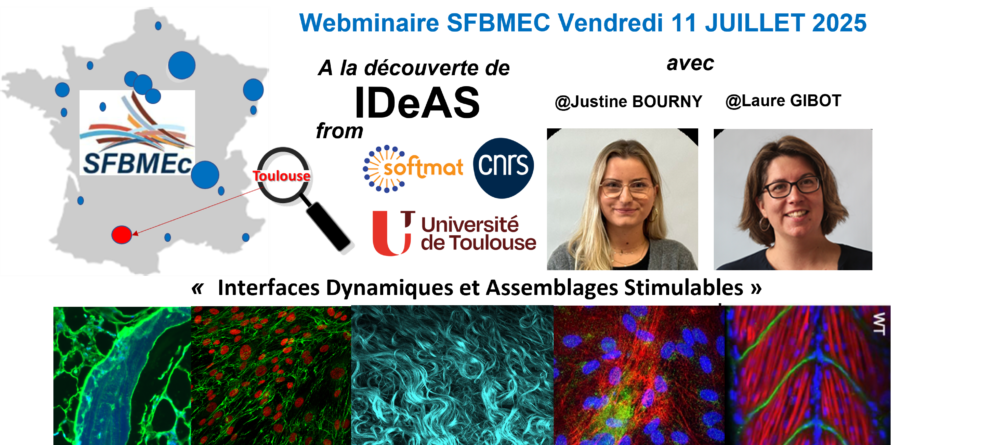Thèse à l’interface Biologie – Biophysique
Développement d’Outils d’analyse du REmodelage Matriciel par Imagerie Haute Résolution (DOREMI).
Durée : 3 ans à compter du 1er octobre 2018
UMR CNRS 7369, Matrice Extracellulaire et Dynamique Cellulaire (MEDyC)
Équipe Modélisation Moléculaire et Imagerie Multi-échelle (MIME)
Université de Reims Champagne Ardenne, UFR Sciences Exactes et Naturelles
Moulin de la Housse, Bât. 18, 51687 Reims cedex 2
Directeur de thèse : Pr. Laurent Debelle
Co-encadrant : Dr. Sébastien Almagro
Contexte
Les maladies cardiovasculaires et métaboliques sont les atteintes les plus observées au cours du vieillissement. Ces pathologies chroniques progressent lentement sans symptôme visible jusqu’à atteindre une situation critique où la maladie est définitivement installée. Lors de ce processus, la matrice extracellulaire vasculaire est dégradée. En particulier, les lames élastiques présentes au sein de la paroi vasculaire sont altérées et ne remplissent plus pleinement leurs rôles. Comme l’élastine qui les compose n’est plus produite au-delà de l’adolescence, toute altération survenant sur ces structures est fondamentalement irréversible et contribue au vieillissement vasculaire.
En collaboration avec nos collègues de l’Université de Manchester, notre laboratoire s’intéresse aux modifications survenant au sein des parois artérielles et à leur évolution, notamment dans le cadre de pathologies liées à l’âge comme le diabète ou l’insuffisance rénale chronique. Nous avons ainsi développé une technique d’imagerie par rayonnement synchrotron X (Diamond Light Source, Didcot, UK) sans agent de contraste qui permet d’obtenir des coupes optiques à très haute résolution (800 nm). Les images obtenues (définition : 2560x × 2560y x 2560z, 16 bits) sur des segments d’artère de souris de plusieurs mm de long permettent de reconstruire le volume artériel et révèlent, au sein des parois, des détails ultra-structuraux jusque-là inconnus.
Nous avons développé un premier programme d’analyse d’image (script Matlab) qui permet d’isoler les structures élastiques contenues dans les parois artérielles en vue de les analyser qualitativement et quantitativement en 3D.
Travail de thèse
Le travail à réaliser dans le cadre de ce projet de thèse comporte deux grands axes ; une partie analyse d’image visant à développer et améliorer l’outil logiciel déjà présent ; une partie imagerie haute résolution qui sera réalisée en étroite collaboration avec nos collègues anglais.
A – Analyse d’image
Le principal objectif de ce projet sera d’améliorer le système d’analyse d’image afin de le rendre plus efficace dans la détection des structures et des modifications structurales des échantillons.
Il faudra ensuite rendre la détection du logiciel moins sensible aux variations de l’échantillon afin que la méthode d’analyse d’image puisse être généralisée afin de simplifier la démarche d’analyse. En effet, des échantillons à comparer peuvent donner lieu à des images ayant une luminosité ou un contraste différent. Le logiciel devra pouvoir s’affranchir de ces différences pour faciliter la comparaison des échantillons entre eux.
Le logiciel développé sera mis en œuvre sur les données d’imagerie haute résolution déjà disponible dans l’équipe, celles qui seront générées lors durant la thèse, mais aussi sur celles obtenues par nos collaborateurs (Angleterre, Espagne, Suisse).
B – Imagerie Synchrotron
Au cours de la thèse, l’étudiant-e sera amené-e à préparer des échantillons en vue de les imager par microtomographie X sur un synchrotron. Il lui appartiendra en particulier d’améliorer la méthode de préparation des échantillons (murins voire humains), afin d’obtenir des échantillons dans un contexte physiologique le plus proche possible des conditions in vivo et d’obtenir la meilleure qualité d’image possible sans utiliser d’agents de contraste.
Ce travail sera principalement réalisé à Reims mais l’étudiant-e recruté-e devra également se rendre en France ou à l’étranger pour acquérir des images sur synchrotron ou réaliser des expériences en lien avec le sujet proposé. Il pourra s’agir de séjours courts (moins d’une semaine) ou plus longs.
Profil recherché
Le-la doctorant-e, biologiste ou bio-informaticien(ne), devra impérativement avoir des connaissances en programmation informatique (exemple : langage orienté objet) et/ou traitement d’image/du signal. Idéalement, la personne aura de plus une première expérience de Matlab et d’ImageJ, mais des compétences en d’autres langages (Python, etc…) peuvent aussi convenir.
L’étudiant-e devra également être capable de préparer les échantillons d’origine animale. Idéalement, la personne aura une première expérience en expérimentation animale. La personne intègrera une équipe de biologistes, bio-informaticiens et biophysiciens d’une dizaine de personnes.
Contact : laurent.debelle@univ-reims.fr et sebastien.almagro@univ-reims.fr
Tél : 03.26.91.35.02 et 03.26.91.81.94
Les personnes intéressées par ce sujet sont invitées à envoyer les éléments suivants.
- CV et lettre de motivation
- Relevés de notes L, M1, M2 + attestation de réussite de Master si déjà disponible
Recrutement :
Le recrutement est organisé par l’Ecole Doctorale Sciences Fondamentales Santé de l’Université de Reims Champagne Ardenne.
Le recrutement aura lieu durant la première quinzaine de septembre, selon un calendrier qui n’est pas encore précisé.
Fiche de renseignement peut être téléchargée en cliquant ici.















































































































































 Dear colleagues,
Dear colleagues,
 The SBCF (French Society for Cell Biology) wishes to extend its invitation to its Annual Symposium to the members of the SFBMEc.
The SBCF (French Society for Cell Biology) wishes to extend its invitation to its Annual Symposium to the members of the SFBMEc.
 Appel à candidature pour des bourses de participation à un congrès international ayant pour thème la matrice extracellulaire.
Appel à candidature pour des bourses de participation à un congrès international ayant pour thème la matrice extracellulaire.

